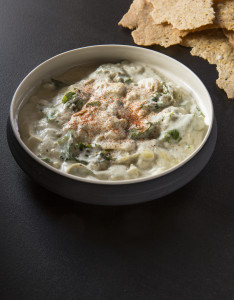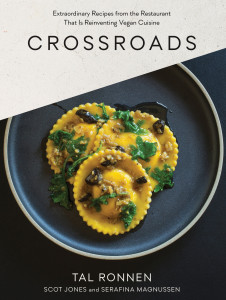When I got the chance to see a copy of the new Crossroads cookbook, I typed “YES PLEASE!!” as fast as possible – and now you have a chance to win a copy as well! Crossroads is a fine dining vegan establishment in LA, and this book is *gorgeous* and everything I would expect from these chefs. If you want to make a fancy vegan meal – this will be your go-to for recipes and ideas.
I love the philosophy expressed in the preface:
Crossroads has a convivial energy and serves wonderful food that one would expect from an upscale restaurant – with the only different being that no animal products are used to prepare it. There are no obvious vegan cues, and most guests don’t even make the connection that the menu is plant-based; they just know the restaurant is comfortable and the food is satisfying and delicious. Crossroads is defined not by what’s missing, but by what it is.
This is my general approach to food, and I love seeing it represented so successfully here. The recipes and photos in this book are making me drool…. :) Starting with a unique twist on spinach-artichoke dip – KALE artichoke dip :D – that they have generously agreed to let me share.

Excerpted from Crossroads by Tal Ronnen with Scot Jones (Artisan Books). Copyright © 2015. Photographs by Lisa Romerein
Read on below for the recipe, but first – how do you win?? :D Comment below with your favorite “fancy” vegan recipe idea. Share this post on facebook, like my facebook page and/or subscribe to my mailing list for additional entries, and leave a separate comment for each telling me that you did so. Winner will be picked randomly from the comments. U.S. entrants only please. Contest closes 11:59PM EST, Thursday, October 15th. Good luck!!

Excerpted from Crossroads by Tal Ronnen with Scot Jones (Artisan Books). Copyright © 2015. Photographs by Lisa Romerein
Warm Kale and Artichoke Dip
Recipe excerpted from Crossroads by Tal Ronnen with Scot Jones (Artisan Books). Copyright © 2015. Photographs by Lisa Romerein
Makes 4 cups
That retro classic, spinach and artichoke dip laden with cream cheese and sour cream, is transformed into a contemporary version that is still rich and creamy but allows the vegetables to shine. Kale’s chewy texture and peppery kick make it a bold stand-in for spinach. When sautéing the artichokes, take care not to let them brown; you want the dip to keep its beautiful pale color. The cashew cream needs to be prepared a day in advance, so plan accordingly. Serve with Harissa Potato Chips, Lentil Crackers, or raw vegetables, or try putting it on baked potatoes or using it as a filling for stuffed pasta, such as cappellacci (page 197).
8 large artichoke hearts (see Note) or two 15-ounce cans artichoke hearts in water
2 tablespoons Earth Balance butter stick
2 shallots, minced
½ cup dry white wine
½ cup dry sherry
1 cup Cashew Cream (page 264)
1 cup Vegetable Stock (page 268) or store-bought stock
½ cup nutritional yeast flakes (see note)
2 tablespoons fresh thyme leaves
6 cups baby kale, coarsely chopped
1 teaspoon kosher salt
½ teaspoon freshly ground black pepper
Smoked paprika, for garnish
1. If using fresh artichoke hearts, bring a large pot of lightly salted water to a boil. Add the artichoke hearts and blanch for 10 minutes, or until slightly tender; a paring knife should slide in easily. Drain the hearts and plunge into an ice bath to “shock” them—i.e., stop the cooking and cool them quickly. Drain and coarsely chop. If using canned artichokes, simply drain and chop.
2. Put a large deep sauté pan over medium heat and add the butter substitute. When it has melted, add the shallots, garlic, and artichoke hearts and cook, stirring, until the vegetables are soft, 6 to 8 minutes.
3. Add the wine and sherry and cook for 1 minute to evaporate some of the alcohol. Add the cashew cream, stock, nutritional yeast flakes, and thyme, reduce the heat to medium-low, and gently simmer until thick, 35 to 40 minutes; stir occasionally to make sure the cream mixture doesn’t stick and burn on the bottom of the pan.
4. Fold in the kale a few handfuls at a time and continue to simmer until the kale is soft and the artichokes have broken down slightly, about 10 minutes. Season with the salt and pepper. (The dip will keep for up to 3 days covered in the refrigerator. To serve, reheat over medium-low heat, stirring often.)
5. If the dip appears too thick, add a couple of tablespoons of stock or water.
6. Spoon the dip into a serving bowl, dust with smoked paprika, and serve with the potato chips, crackers, or sliced raw vegetables.
Artichoke Hearts
To prepare artichoke hearts, fill a large bowl halfway with water. Squeeze in the juice of 2 lemons, and toss the lemon halves into the water too. Working with one artichoke at a time, use a vegetable peeler to trim the tough outer part of the stem. Using a chef’s knife, cut off the top 1 inch of the artichoke crown and then snap off or cut off all of the remaining leaves. Run a paring knife around the base of the artichoke to remove any tough green parts or bits of leaves. Cut the artichoke in half. Using a sharp spoon or a melon baller, scoop out the spiky purple center leaves and fuzzy choke inside and discard. Transfer the prepared artichoke hearts to the lemon water as you work, to keep them from oxidizing and turning brown.
Nutritional Yeast Flakes
Nutritional yeast may not sound like the most appetizing ingredient, but it has a cheesy, nutty, savory quality that gives any dish extra oomph. Just a tablespoon or two adds a creamy, salty richness to dips, soups, and sauces. Look for nutritional yeast flakes in the supplement section of the market or health food store. Be sure to select flakes instead of granules, which will deliver a bit of texture to whatever you add them to.
Cashew Cream
Makes 3 cups
Cashew cream, made from soaking raw cashews and blending them with water, is an indispensable part of my vegan cooking. It stands in for heavy cream in a variety of ways—in the batter for Hearts of Palm Calamari and as a base for Spinach Cream Sauce among others. The cream is at its best when used for cooking; it thickens up even faster than heavy cream and adds richness. You will never miss dairy if you use cashew cream.
It’s essential to use raw cashews to make the cream; the raw nuts have little flavor of their own but provide a fatty creaminess. Roasted cashews taste too strong and won’t blend as well.
Making cashew cream requires planning ahead, since you have to soak the cashews for at least 12 hours. Use only filtered water; the impurities in tap water will add a grayish tinge to the final product. The cream keeps for up to 4 days in the refrigerator and can be frozen for up to 3 months. Thaw it in the refrigerator, at room temperature, or in a large bowl of warm water. The cream will separate upon defrosting, so give it a whirl in a blender to re-emulsify.
2 cups whole raw cashews, rinsed
Filtered water
1. Put the cashews in a bowl and pour in enough cold filtered water to cover. Cover with plastic wrap and refrigerate for at least 12 hours, or up to 1 day.
2. Drain the cashews in a colander and rinse with cold water. Transfer the cashews to a blender, preferably a Vitamix, and pour in enough cold filtered water to cover them by 1 inch, about 3 cups. Blend on high for 2 to 3 minutes, until very smooth and creamy without any trace of graininess. The cashew cream should be smooth on the palate; add more water if necessary. If you’re not using a heavy-duty blender, you may need to strain the cashew cream through a fine-mesh sieve to get rid of any grittiness.
3. Cover and refrigerate until ready to use. It will thicken as it sits, so blend with ½ cup or so filtered water if needed to reach the desired consistency. It can also be frozen; see the headnote.
Variation
Makes 2 cups
1. To make thick cashew cream, reduce the amount of water in the blender so that it just covers the cashews, about 2 cups.
Vegetable Stock
Makes about 1 gallon
A flavorful stock is one of the fundamentals of cooking. A good stock should enhance, rather than overwhelm, whatever sauce or dish you make with it. Every layer of flavor creates the sum of the parts, so the goal with making stock is versatility. This vegetable stock has a fairly neutral flavor that works in all kinds of preparations. The recipe couldn’t be easier—chop up some vegetables, cover with water, and simmer—you’re done.
The majority of commercial brands of vegetable stock are too dark in color and overly salty and/or sweet. If you’re pressed for time and must use a prepared stock, More Than Gourmet is our favorite. It has no artificial anything and contains no MSG or excess sodium.
2 celery stalks, quartered
2 fennel bulbs, coarsely chopped
2 leeks, trimmed, halved lengthwise, and washed
2 carrots, halved
1 onion, halved
4 garlic cloves, smashed
2 bay leaves
2 teaspoons whole black peppercorns
12 fresh flat-leaf parsley sprigs
6 fresh thyme sprigs
1 teaspoon kosher salt
About 1 gallon cold filtered water
1. Combine the vegetables, bay leaves, peppercorns, herb sprigs, and salt in a large stockpot and add enough cold filtered water to cover. Slowly bring to a boil over medium heat, then reduce the heat to low and gently simmer, uncovered, for 45 minutes. Turn off the heat and let the stock steep and settle for 10 minutes.
2. Strain the stock through a fine-mesh sieve into another pot; discard the solids. Place the pot in a sink full of ice water and stir to cool the stock down quickly. The stock can be covered and refrigerated for up to 1 week or frozen for up to 1 month.


I love making vegan chocolate mousse!
Usually I go with a fancy Mediterranean soup and a vegetable dip. It can be as fancy as you want it. Looked at the book preview, love how their boldness (e.g they smoked beans without using liquid smoke -open the windows and remove you smoke detector battery)
Congrats Tammy; you have won!! I loved that line in the book too!! :D
I shared on fb Steph Michelle
When I do fancy vegan I do
Stuffed shells but with tofu instead of ricotta!!